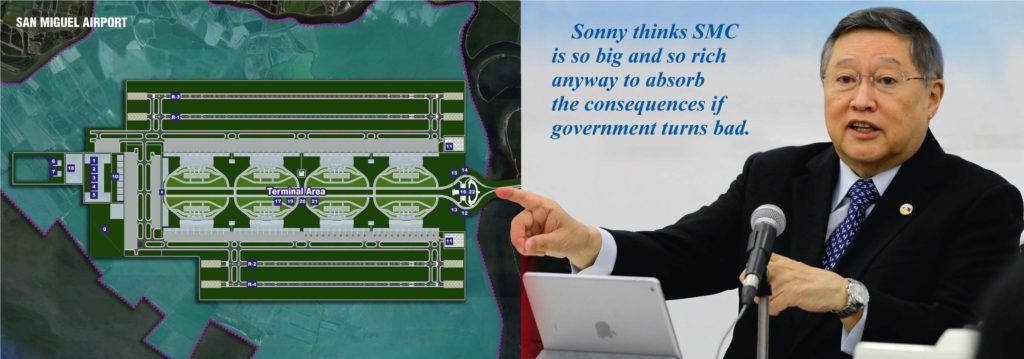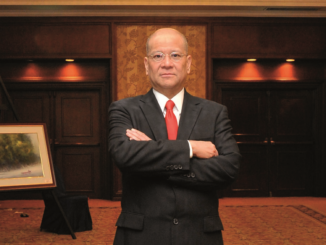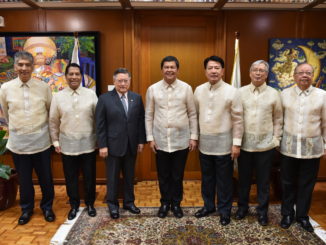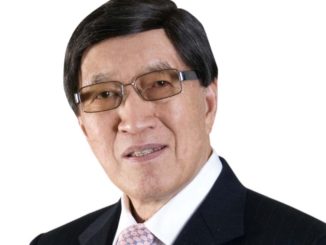
(Statement before the joint hearing of the Senate Committees on Public Services and Economic Affairs, Sept. 10, 2018)
Thank you for inviting us to today’s Senate hearing, your honors, and for giving us an opportunity to answer your questions on the Department of Finance’s involvement in the approval of the airport projects.
For us, the message in the last hearing and today also is clear – the government should accelerate the approval and implementation of airport proposals to ensure that tourists and our kababayans do not suffer should an incident similar to the Xiamen Air mishap recur.
On the call of this honorable committee for government to fast-track the implementation of airport proposals, we completely agree. We understand that as early as 2011, a Japan International Cooperation Agency report was already released discussing the problems of NAIA’s capacity, which incidentally was not acted upon by the past administration.
One of the first acts of this administration was to begin the rehabilitation of the Clark International Airport to partially address the NAIA capacity problem. We were the first ones to take action. However, we simply cannot wave the magic wand and fix the problem overnight.
This is why we at the DOF were puzzled when we heard that we were being invited today by the honorable chairperson of this committee to a hearing on the modernization and expansion of airports. In the last hearing, it was stated that the DOF “needs to answer why they are hampering or delaying the approval of these projects.”
San Miguel’s Bulacan Airport
Before we share with this committee our role in the approval of airport projects, let us first go back to the time the Bulacan International Airport proposal was presented.
In a meeting in January 2018, the following questions came to our mind: First, how will the Bulacan Airport affect the Clark International Airport, given the government’s investments in Clark? Your honors, all airport projects are real estate projects.
The real estate value of the New Clark City is currently $14 billion and government has committed an additional P12 billion. We wanted to know how the Bulacan Airport, which is just 65 kilometers away from Clark, will affect the value of the New Clark City, which is by the way, the property of the Filipino people.
Second, how will the Bulacan International Airport affect traffic in the area? Do we need additional lanes in the North Luzon Expressway to be constructed? Do we need to change the alignment of the proposed rail system to Clark?
Third, who is the proponent and what is its actual financial capability?
We wanted to know whether the proponent, San Miguel Holdings Corp., actually had the financial capacity to undertake the project. Initially, the Department of Transportation (DOTr) reported that San Miguel Holdings had a total equity of P60 billion in 2016.
Considering the usual financing mix of 70% debt and 30% equity in a Public-Private Partnership (PPP) project, the construction of the Bulacan Airport will require San Miguel Holdings to infuse around P200 billion inequity, which we are not sure is going to happen.
In order to answer these questions, among others, a second meeting was required. In April of 2018, the project was approved by the NEDA Board.
As a condition for the approval, we were required to submit our inputs. Even though we thought it was not proper for us to submit our comments as the Implementing Rules and Regulations of Republic Act No. 6957, or the “BOT Law,” provides that the DOF shall review the draft contract once negotiations are completed, nevertheless we compiled the issues discussed at the NEDA-ICC and Board meetings.
No new comments
Contrary to statements made in the last hearing, we guarantee that there were no new comments added that were not already discussed before the NEDA Board approval. We take this opportunity to categorically say we have not caused the delay in the Bulacan Airport.
As a matter of fact, we are even providing assistance to accelerate the approval and implementation of the project.
One of the helpful suggestions we made to the DOTr was to require the execution of a joint and several liability agreement, which would make San Miguel Corp., the parent company, stand behind San Miguel Holdings, the private proponent, which is financially at this point incapable of undertaking a P700-billion project.
However, in page 5, Item P of the draft minutes of the meetings of April 25, 2018 6th NEDA Board meeting, a representative from the Office of the President stated that “the financial capacity of the proponent corporation should be the one evaluated and not the financial capacity of the mother company backing the proponent corporation.” That’s not my comment ma’am, that is somebody else’s.
As regards the DOF’s role in the approval process of airport projects, Book IV, Title II, Chapter 1, Section 1 of Executive Order No. 292 series of 1987, or the “Administrative Code,” provides that the mandate of our department is to ensure the sound and efficient management of financial resources of the government.
It is my responsibility to not only look after all of government assets, but also manage our contingent liability, which for the information of this body, is estimated now to be at least P309 billion as of 2018 for PPP projects.
Meticulous evaluation
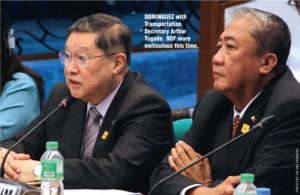 Meticulous evaluation is necessary since in several instances, projects that were approved in the past by the NEDA Board were more profitable than projections during the appraisal stage.
Meticulous evaluation is necessary since in several instances, projects that were approved in the past by the NEDA Board were more profitable than projections during the appraisal stage.
Let me give you a concrete example. The Mactan-Cebu International Airport is actually earning more profits than projected. In 2017, it registered a net income of P1.1 billion.
This is 48% higher than the P752 million forecasted in the financial model of the project. This indicates that the actual returns of the concessionaire will be significantly larger than what was originally estimated.
And yet, government still made the commitment that there will be no other competing airports in Mactan and Cebu.
Reimbursement?
Now, should the government later on want to build a new airport in the area to serve OFWs and other tourists, we would be required to reimburse not just market value of the infrastructure assets, but also all the future profits of the commercial business until the end of the concession.
This means that we would have to reimburse the concessionaire in Mactan around P20 billion just to build another airport.
While P309 billion is an alarming number, what is more worrying to us are the type of commitments we guarantee. Let me give you another example.
In Mactan airport
Moreover, as I mentioned, in the Mactan-Cebu International Airport concession agreement, the government committed that if it causes to operate any international or domestic airport in the Mactan and Cebu Islands, it is considered the grantor in default – that’s the government – making us liable for termination payments. Essentially, it will cost us a tremendous amount of money to build a new airport in these areas even if there is an unexpected increase in passenger demand.
Your honors, these examples emphasize that the actions we do and documents we sign have ripple effects on the next generations.
Consequences from poor decisions
The burden is upon my office to ensure that future generations do not suffer consequences from poor decisions of previous governments, as Book IV, Title II, Chapter 1, Section 2 of the Administrative Code of 1987, and as reiterated in the Department of Justice Opinion Nos. 61 series of 2004 and 13 series of 2013, states that the issuance of the performance undertakings is within the discretionary power of the DOF, it being mandated by law to be primarily responsible “for the sound and efficient management of the financial resources of the government, its subdivisions, agencies and instrumentalities” and “for the formulation, institutionalization and administration of fiscal policies in coordination with other concerned subdivisions, agencies and instrumentalities of government.”
Let me ask you a question: why don’t we compare a farmer with a company investing in an airport?
The farmer has no access to financing. He does not even own the land. In fact, he is the one who needs a subsidy or government guarantee.
But these corporations who are making tremendous profit, with access to banks, require a guarantee even if it is their own fault that an airport is not operational.
These government guarantees for force majeure and material adverse government actions can make a project tangible, but it will not turn a bad project into a good one.
Thank you.
Poe: Fast track airport projects
If you believe her, Senator Grace Poe wants all the major airport projects to proceed – expansion of the Ninoy Aquino International Airport, expansion of Clark Airport, new Sangley airport on proposed reclaimed land, and San Miguel Corp.’s P750-billion New Manila International Airport in Bulacan town, Bulacan province, 27 kms north of NAIA.
“Speedy construction of new airports and expansion of existing ones will address congestion as overcapacity hounds the country’s gateway,” said Poe, chair of the Senate Committee on Public Services.
Her committee wrapped up on Sept. 10, 2018 its investigation into the stalling of a Chinese passenger aircraft at the Ninoy Aquino International Airport (NAIA) and other airport concerns, will include in the committee report.
“Ilalagay natin sa committee report yung naging diskusyon natin sa airport modernization…Malaking bagay iyan dahil sa Bulacan airport pa lamang ay ilang milyong pasahero ang madadagdag na makagagaan sa ating mga pasahero. At yung rehabilitation, until 65 million passengers ang magiging capacity ng NAIA. Malaking bagay at siguro hindi na sila magsisiksikan sa mga terminal,” Poe told reporters after the second hearing on Monday, Sept. 10.
Officials present at the hearing told senators they are pursuing a multi-airport policy within Metro Manila and nearby provinces, and have in fact accepted proposals to develop NAIA, Clark International Airport in Pampanga, Sangley Point in Cavite, a new airport in Bulacan, as well as the development of Subic airport.
NAIA, which only has a capacity of 31 million passengers, booked 42.5 million passengers last year.
As for Clark, senators were told that expansion of Clark airport, which is being groomed as an alternative to the already congested NAIA, will be completed in 2020 and will increase its capacity to 12 million while the upgrade of NAIA, which will be developed by a “super consortium” composed of seven conglomerates, is scheduled to be initially completed by 2021 and is anticipated to increase capacity to 65 million passengers.
Subic airport is being revived to get it back to international standards; Sangley airport, which is currently used by the Philippine military, is proposed by the Cavite provincial government and another private consortium as an international hub to handle some 70 million passengers; and a new airport in Bulakan, Bulacan by San Miguel Holdings (SMH) is expected to handle 100 million passengers and may be operational by 2024.
“The government should accelerate the approval and implementation of airport proposals to ensure that tourists and our kababayans do not suffer…On the call of this Honorable Committee for government to fast-track the implementation of the airport proposals, we completely agree,” Finance Secrerary Carlos Dominguez assured the senators.
Dominguez raised concerns as to the financial viability of SMH, a subsidiary of San Miguel Corp., in financing a massive P750- billion airport project.
The Finance chief noted that SMHC had total equity of P60 billion and may need to shell out P200 billion, assuming a 70-30 debt-equity in project ratio.
“Financially, at this point, [SMH is] incapable of undertaking a P700-billion project,” Dominguez opined. He wants parent company, San Miguel Corp. (SMC), to guarantee the Bulacan airport project as he believes SMC’s capitalization is enough to finance the bid.
The committee noted the concerns raised by the Finance official as regards the financial capacity of the proponent firm of the Bulacan mega airport, as well as connectivity to Manila and capacity of existing roads to handle a mammoth project.
Poe said she wants assurance the “terminal fees will not skyrocket” once the different airport projects are completed.
Full statement
The following is Senator Poe’s closing statement after the hearings:
First, we learned that CAAP’s investigation on the Xiamen incident is still ongoing. Maybe if it takes more time, I might ask for an executive session, but for now we will let it go through its proper course.
Second, we were informed of the existence of a “disabled aircraft removal plan” which sets the protocols for such incidents. Specifically, the primary responsibility to remove disabled aircraft lies with the airline operator.
Finally, and most importantly, we heard the testimony of affected passengers.
On the third point, nakakabahala ang mga narininig natin: kulang sa pagkain at upuan, at mahina ang sound system. Hindi malaman kung kailan matutuloy ang kanilang flight. Pati sa pag-book ng accommodation, nahirapan sila. At mismong mainit na tubig para sa kape at cup noodles ay pinagkakakitaan ng sampung piso. Dapat ang mga concessionaires diyan sa airport ay pagsabihan rin not to take advantage of the situation.
Review contingency plans
We need to review our contingency plans for such situations. I would like to ask the CAB to please assist passengers who have any concerns. You said that you’re already going to help Ms. Del Rosario and the others who are also experiencing situations like that. The crisis management teams need to be meeting to establish greater coordination between airlines and MIAA, not on a voluntary basis but mandatory.
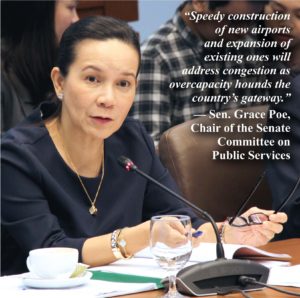 These hearings were not meant to disparage the efforts of our airport and airline staff. Dealing with irate, hungry, and tired passengers is not an easy task. Alam ko marami sa inyo did your best given the situation and we are learning from this. Even the General Manager, you were basically crucified when everybody was talking about this. We see the effort. Moving forward, I hope that we will prevent this from happening again. We don’t really get a free pass but I think that we should be a little more considerate because this is the first time this has happened.
These hearings were not meant to disparage the efforts of our airport and airline staff. Dealing with irate, hungry, and tired passengers is not an easy task. Alam ko marami sa inyo did your best given the situation and we are learning from this. Even the General Manager, you were basically crucified when everybody was talking about this. We see the effort. Moving forward, I hope that we will prevent this from happening again. We don’t really get a free pass but I think that we should be a little more considerate because this is the first time this has happened.
These lessons will be enshrined in our Committee report, for the reference of future generations.
Outcomes needed
Finally, without pre-empting the findings of our Committee report, we seek the following outcomes from those who participated in our proceedings:
First, the CAAP should immediately complete its investigation and issue recommendations.
Second, Xiamen Airlines should fully and unconditionally cooperate with the government, especially with regard to the payment of all damages. As I mentioned, CAB, tulungan ang mga pasahero. Airlines, kapag may delay, what will you do? Please submit to us again what your plans will be moving forward. And also in terms of feeding the passengers that are waiting, para hindi rin masayang ang mga pagkain.
Why the delay in the SMC airport
On the new airport, I would like to thank Secretary Dominguez for also joining us today. He mentioned and clarified that the DOF is not the cause of delay of the Bulacan airport or any other projects. There are considerations which we appreciate; implications to the economy and the state as a whole; the burden to the Filipino public or the advantage; the effect to roads and transportation, and financial viability of the corporation.
The committee will also assess the issues fully to help the country and our countrymen. I would like to ask from Undersecretary Ruben Reinoso the deadlines that you mentioned, all of them: from the Bulacan airport, the consortium, and the roadmap also from the DOTr and a copy of the JICA study, again.
The consortium, please submit to us your promises, what are your plans to improve passenger safety and also convenience?
The CAB, please give us the matrix for the fuel surcharge.
SMC agrees with Dominguez. It will back up subsidiary San Miguel Holdings Corp. in building its $15B New Manila International Airport
San Miguel Corp. (SMC) agrees with Secretary Dominguez on his position that the conglomerate should financially back up San Miguel Holdings Corp. (SMHC) in building the $15 billion New Manila Airport Project in Bulacan.
In fact, as early as May 18, following the approval of the project by the NEDA board, SMHC conveyed to the Department of Transportation (DoTr) SMC’s willingness to execute a joint and several liability agreement soon as the terms of the concession agreement (CA) are finalized with the government. The final CA will form the basis of what SMC will be guaranteeing and jointly liable for.
Very simply, the joint and several liability undertaking means that the project will be fully backed by the financial capability of SMC, the parent company of SMHC.
SMC is more than capable to handle the airport project.
The historical performance of the conglomerate reflects this: strong balance sheet, consistent profitability, sustained growth and liquidity, clearly supporting its expansion and acquisition activities.
The project, estimated at $15 billion, will be undertaken over a period of 5-7 years to full completion. On average, spending spread is about P100 billion which is at the level of the company’s cash from operating activities on a simple annualized basis.
There is a substantial debt space to supplement cash requirements for SMC’s priority projects and those of its various business units. Its net debt to EBITDA ratio is also way below the company’s debt covenant of 5.5x.
Given the importance, impact and urgency of building a modern, world-class airport to the nation and the Filipino people, SMC and SMHC will abide by the demands of the Department of Finance (DoF) to ensure the project takes off.
Why the delay in SMC’s airport
Now it’s official. Finance Secretary Carlos Dominguez did indeed question the viability of San Miguel Corp.’s P750 billion airport in Bulacan, 27 kms north of the present Ninoy Aquino International Airport.
He raised the issue of viability (and therefore, stymied the new airport project) because Sonny was worried the government would suffer the consequences if it turned out the SMC project would be unprofitable in the long run—because of government actions.
Dominguez’s objections are anchored on two issues:
One, can San Miguel Holdings Corp., the airport proponent which is wholly owned by San Miguel Corp., afford the P750-billion airport when it has only P60 billion equity (capital put in by owner SMC). Sonny wants the mother company, SMC, to guarantee all the liabilities of subsidiary, SMHC. Done, says SMC President Ramon S. Ang. SMC has P1.4 trillion resources (its food business alone is worth annually P650 billion, power business P270 billion, and Petron P266 billion), P420 billion equity, instant cash of P222.5 billion
Two, exemption for the government from liabilities or compensation “for force majeure and material adverse government actions” if a good project turns out to be bad because of decisions, policies, and laws made by the government itself.
This is like saying San Miguel cannot run after or sue the government if government itself opts to be naughty later on and does all kinds of foolishness when the airport is operational.
Sonny thinks SMC is so big and so rich anyway to absorb the consequences if government turns bad.
RSA’s reaction: What! (expletive deleted).
The Finance chief was worried because in Mactan airport, the government made substantial and liberal commitments to its proponents, Megawide and its Indian partners. Those commitments were made by the unlamented administration of President Noynoying Aquino III.
Dominguez implied that the past administration made mistakes in making guarantees to the Megawide-Indian group now managing the Mactan Cebu airport.
So now, he wants to be “meticulous” with the SMC airport.
Interestingly, Dominguez allowed the superbody National Economic and Development Authority which is headed by President Duterte himself, to approve the SMC airport plan (last April 2018). Four months later, last August, with the XiamenAir accident, the DOF chief raised crucial questions that in effect negated the approval.
Dominguez elaborated on government commitments to Megawide when he appeared before the hearing of the combined Senate Committees of Public Services and Economic Affairs, Sept. 10, 2018.
Airport contributes P1.7T
Public Services because an airport is a public service. Economic Affairs because an airport like the size that will soon replace the NAIA contributes 9% to the economy, about P1.53 trillion annually out of total GDP of P17 trillion.
Which means that if the NAIA, which services 41 million passengers a year, were to shut down and there is no immediate replacement, as what happened when XiamenAir flight MF 8667 crash-landed midnight of Aug. 1, 2018 disabling the Philippine gateway for nearly two days, the damage to the economy would be enormous – P5 billion or P2.5 billion per day.
“Meticulous evaluation is necessary since in several instances, projects that were approved in the past by the NEDA Board were more profitable than projections during the appraisal stage,” Dominguez explained to the senators.
In the Mactan airport project, Sonny pointed out:
- The government made the commitment that there will be no other competing airports in Mactan and Cebu.
This, despite the fact that the Mactan-Cebu International Airport is actually earning more profits than projected. In 2017, it registered a net income of P1.1 billion. This is 48% higher than the P752 million forecast in the financial model of the project.
“This indicates that the actual returns of the concessionaire will be significantly larger than what was originally estimated,” noted Dominguez, himself a former banker and an astute businessman in his own right before joining the Duterte government.
He and Duterte were high school classmates. Dominguez topped their class. Duterte had poor grades.
Explained Dominguez: “In the Mactan-Cebu International Airport concession agreement, the government committed that if it causes to operate any international or domestic airport in the Mactan and Cebu Islands, it is considered the grantor in default – that’s the government – making us liable for termination payments. Essentially, it will cost us a tremendous amount of money to build a new airport in these areas even if there is an unexpected increase in passenger demand.”
- ”Should the government later on want to build a new airport in the area to serve OFWs and other tourists, we would be required to reimburse not just market value of the infrastructure assets, but also all the future profits of the commercial business until the end of the concession. This means that we would have to reimburse the concessionaire in Mactan around P20 billion just to build another airport,” Dominguez explained.
“While P309 billion is an alarming number, what is more worrying to us are the type of commitments we guarantee,” he said, talking about other projects.
- “There are potential claims by water concessionaires (Manila Water and Maynilad Water) against the government, estimated at P80 billion, just because a Performance Undertaking was executed by a former DOF secretary guaranteeing that the government will not interfere or question water utility rates.”
“These examples,” said Dominguez, “emphasize that the actions we do and documents we sign have ripple effects on the next generations.”
He added: “The burden is upon my office to ensure that future generations do not suffer consequences from poor decisions of previous governments.”
“Book IV, Title II, Chapter 1, Section 2 of the Administrative Code of 1987, and as reiterated in the Department of Justice Opinion Nos. 61 series of 2004 and 13 series of 2013, states that the issuance of the performance undertakings is within the discretionary power of the DOF, it being mandated by law to be primarily responsible ‘for the sound and efficient management of the financial resources of the government, its subdivisions, agencies and instrumentalities’ and ‘for the formulation, institutionalization and administration of fiscal policies in coordination with other concerned subdivisions, agencies and instrumentalities of government’.”
Question: Why does San Miguel have to suffer the consequences of bad decisions by previous governments in other projects? n

